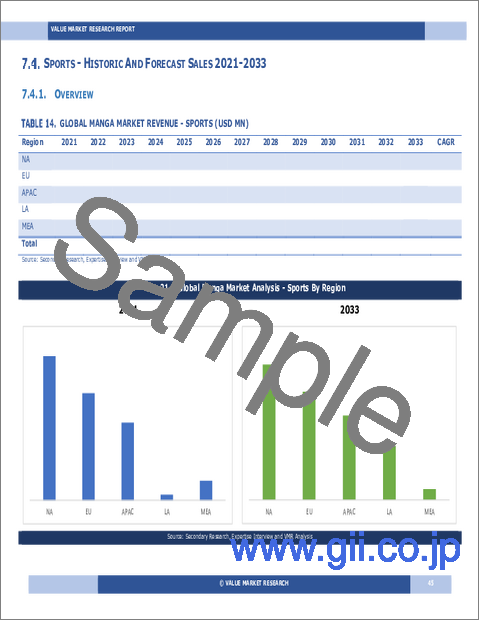|
|
市場調査レポート
商品コード
1782628
マンガの世界市場調査レポート:産業分析、規模、シェア、成長、動向、2025年から2033年までの予測Global Manga Market Research Report- Industry Analysis, Size, Share, Growth, Trends and Forecast 2025 to 2033 |
||||||
カスタマイズ可能
|
|||||||
| マンガの世界市場調査レポート:産業分析、規模、シェア、成長、動向、2025年から2033年までの予測 |
|
出版日: 2025年08月01日
発行: Value Market Research
ページ情報: 英文 234 Pages
納期: 即日から翌営業日
|
全表示
- 概要
- 図表
- 目次
世界のマンガ市場規模は、2024年の160億4,000万米ドルから2033年には665億8,000万米ドルに成長し、2026~2033年の予測期間中に17.13%の堅調な年間平均成長率(CAGR)を示すと予測されます。
マンガ市場は、日本文化やエンタテインメントの世界の人気の高まりに後押しされ、ダイナミック変貌を遂げています。デジタルプラットフォームが普及するにつれ、マンガへのアクセスはより広範になり、さまざまな背景を持つファンがこのユニークな芸術形態に触れることができるようになりました。ストリーミングサービスやオンライン読書プラットフォームの台頭は、マンガへのアクセスを民主化し、クリエイターが印刷物流通の伝統的障壁なしに国際的な視聴者にリーチすることを可能にしました。この変化は読者層を拡大するだけでなく、ディスカッションやファンアート、コスプレに積極的に参加するファンの活気あるコミュニティを育み、マンガへの関心をさらに高めています。
さらに、マンガのジャンルが多様化していることも、マンガの成長軌道に寄与しています。伝統的少年漫画や少女漫画の人気が衰えない一方で、異世界、ホラー、スライス・オブ・ライフといったニッチなジャンルへの関心が急増しています。このような多様化は、より幅広い嗜好や嗜好に対応し、これまでマンガに手を出さなかった読者を惹きつける。さらに、マンガ家と欧米の出版社とのコラボレーションの増加は、文化的要素を融合させたハイブリッド作品の出現につながり、世界中の読者にアピールしています。こうしたコラボレーションが盛んになるにつれ、市場のダイナミズムと革新性が高まると考えられます。
さらに、マンガ市場は戦略的パートナーシップや他のメディアへの翻案を通じて成長する態勢が整っています。人気マンガのアニメ化、映画化、ビデオゲーム化は、フランチャイズの裾野を広げる有益な手段であることが証明されています。このような映画化は、原作マンガに新たな視聴者を呼び込むだけでなく、クリエイターや出版社に新たな収入源をもたらします。マンガと他のエンタテインメントの相乗効果が強まるにつれ、市場は持続的な成長を遂げ、世界のポップカルチャーの要としての地位を確固たるものにすると予想されます。
当社のレポートは、様々な産業や市場に関する包括的かつ実用的な洞察を顧客に提供するために、綿密に作成されています。各レポートは、市場情勢を完全に理解するために、いくつかの重要な要素を含んでいます。
市場概要:定義、分類、産業の現状など、市場に関する詳細なイントロダクション。
市場力学:市場成長に影響を与える主要促進要因・抑制要因・機会・課題を詳細に分析します。このセクションでは、技術の進歩、規制の変更、新たな動向などの要因を検証します。
セグメンテーション分析:製品タイプ、用途、エンドユーザー、地域などの基準に基づき、市場を明確なセグメントに内訳。この分析により、各セグメントの業績と将来性を明らかにします。
競合情勢:市場シェア、製品ポートフォリオ、戦略的イニシアティブ、財務実績など、主要市場参入企業の包括的評価。主要企業が採用する競合力学と主要戦略に関する考察を記載しています。
市場予測:過去のデータと現在の市場状況に基づき、一定期間における市場規模と成長動向を予測します。これには、定量的分析と将来の市場軌跡を示すグラフ表示が含まれます。
地域分析:地域による市場パフォーマンスを評価し、主要市場や地域動向を明らかにします。地域の市場力学とビジネス機会を理解するのに役立ちます。
新たな動向と機会:現在の市場動向と新たな市場動向、技術革新、潜在的な投資対象セグメントを特定します。将来の開発と成長展望に関する洞察を記載しています。
目次
第1章 序文
第2章 エグゼクティブサマリー
- 市場のハイライト
- 世界市場スナップショット
第3章 マンガ産業分析
- イントロダクション:市場力学
- 市場促進要因
- 市場抑制要因
- 機会
- 産業動向
- ポーターのファイブフォース分析
- 市場の魅力分析
第4章 バリューチェーン分析
- バリューチェーン分析
- 原料分析
- 原料リスト
- 原料メーカー一覧
- 主要原料の価格動向
- 潜在的バイヤーリスト
- マーケティングチャネル
- 直接マーケティング
- 間接マーケティング
- マーケティングチャネル発展動向
第5章 マンガの世界市場分析:コンテンツタイプ別
- コンテンツタイプ別概要
- コンテンツタイプ別過去・予測データ分析
- 印刷
- デジタル
第6章 マンガの世界市場分析:流通チャネル別
- 流通チャネル別概要
- 流通チャネル別過去・予測データ分析
- オンライン
- オフライン
第7章 世界のマンガ市場分析:ジャンル別
- ジャンル別概要
- ジャンル別過去・予測データ分析
- アクション
- SF・ファンタジー
- スポーツ
- ロマンス&ドラマ
- その他
第8章 マンガの世界市場分析:読者層別
- 読者層別概要
- 読者層別過去・予測データ分析
- 幼児
- 青年
- 成人
第9章 マンガの世界市場分析:地域別
- 地域別展望
- イントロダクション
- 北米の売上分析
- 概要、実績と予測
- 北米:セグメント別
- 北米:国別
- 米国
- カナダ
- メキシコ
- 欧州の売上分析
- 概要、実績と予測
- 欧州:セグメント別
- 欧州:国別
- 英国
- フランス
- ドイツ
- イタリア
- ロシア
- その他の欧州
- アジア太平洋の売上分析
- 概要、実績と予測
- アジア太平洋:セグメント別
- アジア太平洋:国別
- 中国
- インド
- 日本
- 韓国
- オーストラリア
- 東南アジア
- その他のアジア太平洋
- ラテンアメリカの売上分析
- 概要、実績と予測
- ラテンアメリカ:セグメント別
- ラテンアメリカ:国別
- ブラジル
- アルゼンチン
- ペルー
- チリ
- その他のラテンアメリカ
- 中東・アフリカの売上分析
- 概要、実績と予測
- 中東・アフリカ:セグメント別
- 中東・アフリカ:国別
- サウジアラビア
- アラブ首長国連邦
- イスラエル
- 南アフリカ
- その他の中東・アフリカ
第10章 マンガ企業の競合情勢
- マンガ市場の競合
- 提携・協力・契約
- 合併・買収
- 新製品発売
- その他の開発
第11章 企業プロファイル
- 上位企業の市場シェア分析
- 市場集中度
- Shueisha Inc.
- Shogakukan Inc
- Yen Press
- VIZ Inc.
- Houbunsha Co. Ltd.
- Bilibili Comics
- Seven Seas Entertainment Inc.
- Kadokawa Corporation
- Akita Publishing Co. Ltd.(Akita Shoten Co. Ltd)
- Kodansha Ltd.
- IDW Media Holdings
- DMG Entertainment Inc.
- Futabasha Publishers Ltd.
- Archie Comic Publications Inc.
- Titan Books(Titan Entertainment Group)
LIST OF TABLES
- Market Snapshot
- Drivers: Impact Analysis
- Restraints: Impact Analysis
- List of Raw Material
- List of Raw Material Manufactures
- Analysis By Content Type (USD MN)
- Printed Market Sales By Geography (USD MN)
- Digital Market Sales By Geography (USD MN)
- Analysis By Distribution Channel (USD MN)
- Online Market Sales By Geography (USD MN)
- Offline Market Sales By Geography (USD MN)
- Analysis By Genre (USD MN)
- Action & Audience Market Sales By Geography (USD MN)
- Sci-Fi & Fantasy Market Sales By Geography (USD MN)
- Sports Market Sales By Geography (USD MN)
- Romance & Drama Market Sales By Geography (USD MN)
- Others Market Sales By Geography (USD MN)
- Analysis By Audience (USD MN)
- Children & Kids Market Sales By Geography (USD MN)
- Teenagers Market Sales By Geography (USD MN)
- Adults Market Sales By Geography (USD MN)
- Global Manga Market Sales By Geography (USD MN)
- North America Market Analysis (USD MN)
- United States Market Analysis (USD MN)
- Canada Market Analysis (USD MN)
- Mexico Market Analysis (USD MN)
- Europe Market Analysis (USD MN)
- Europe Market Estimate By Country (USD MN)
- United Kingdom Market Analysis (USD MN)
- France Market Analysis (USD MN)
- Germany Market Analysis (USD MN)
- Italy Market Analysis (USD MN)
- Russia Market Analysis (USD MN)
- Spain Market Analysis (USD MN)
- Rest of Europe Market Analysis (USD MN)
- Asia Pacific Market Analysis (USD MN)
- China Market Analysis (USD MN)
- Japan Market Analysis (USD MN)
- India Market Analysis (USD MN)
- South Korea Market Analysis (USD MN)
- Australia Market Analysis (USD MN)
- South East Asia Market Analysis (USD MN)
- Rest of Asia Pacific Market Analysis (USD MN)
- Latin America Market Analysis (USD MN)
- Brazil Market Analysis (USD MN)
- Argentina Market Analysis (USD MN)
- Peru Market Analysis (USD MN)
- Chile Market Analysis (USD MN)
- Rest of Latin America Market Analysis (USD MN)
- Middle East & Africa Market Analysis (USD MN)
- Saudi Arabia Market Analysis (USD MN)
- UAE Market Analysis (USD MN)
- Israel Market Analysis (USD MN)
- South Africa Market Analysis (USD MN)
- Rest of Middle East and Africa Market Analysis (USD MN)
- Partnership/Collaboration/Agreement
- Mergers And Acquisition
LIST OF FIGURES
- Research Scope of Manga Report
- Market Research Process
- Market Research Methodology
- Global Manga Market Size, By Regions (USD MN)
- Porters Five Forces Analysis
- Market Attractiveness Analysis By Content Type
- Market Attractiveness Analysis By Distribution Channel
- Market Attractiveness Analysis By Genre
- Market Attractiveness Analysis By Audience
- Market Attractiveness Analysis By Regions
- Value Chain Analysis
- Global Market Analysis By Content Type (USD MN)
- Printed Market Sales By Geography (USD MN)
- Digital Market Sales By Geography (USD MN)
- Global Market Analysis By Distribution Channel (USD MN)
- Online Market Sales By Geography (USD MN)
- Offline Market Sales By Geography (USD MN)
- Global Market Analysis By Genre (USD MN)
- Action & Audience Market Sales By Geography (USD MN)
- Sci-Fi & Fantasy Market Sales By Geography (USD MN)
- Sports Market Sales By Geography (USD MN)
- Romance & Drama Market Sales By Geography (USD MN)
- Others Market Sales By Geography (USD MN)
- Global Market Analysis By Audience (USD MN)
- Children & Kids Market Sales By Geography (USD MN)
- Teenagers Market Sales By Geography (USD MN)
- Adults Market Sales By Geography (USD MN)
- Global Market Sales (USD MN)
- North America Market Sales (USD MN)
- Europe Market Sales (USD MN)
- Asia Pacific Market Sales (USD MN)
- Latin America Market Sales (USD MN)
- Middle East & Africa Market Sales (USD MN)
- Recent Development in Industry
- Top Company Market Share Analysis
Kindly note that the above listed are the basic tables and figures of the report and are not limited to the TOC.
Global Manga Market size is anticipated to grow from USD 16.04 Billion in 2024 to USD 66.58 Billion by 2033, showcasing a robust Compound Annual Growth Rate (CAGR) of 17.13% during the forecast period of 2026 to 2033.
The manga market is experiencing a dynamic transformation, fueled by the increasing global popularity of Japanese culture and entertainment. As digital platforms proliferate, access to manga has become more widespread, allowing fans from diverse backgrounds to engage with this unique art form. The rise of streaming services and online reading platforms has democratized access to manga, enabling creators to reach international audiences without the traditional barriers of print distribution. This shift is not only expanding the readership base but also fostering a vibrant community of fans who actively participate in discussions, fan art, and cosplay, further driving interest in manga.
Moreover, the diversification of manga genres is contributing to its growth trajectory. While traditional shonen and shojo titles remain popular, there is a burgeoning interest in niche genres such as isekai, horror, and slice-of-life. This diversification caters to a wider array of tastes and preferences, attracting readers who may not have previously engaged with manga. Additionally, the increasing collaboration between manga creators and Western publishers is leading to the emergence of hybrid works that blend cultural elements, appealing to a global audience. As these collaborations continue to flourish, they will likely enhance the market's dynamism and innovation.
Furthermore, the manga market is poised for growth through strategic partnerships and adaptations in other media. The successful adaptation of popular manga into anime series, films, and video games has proven to be a lucrative avenue for expanding the franchise's reach. These adaptations not only introduce new audiences to the original manga but also create additional revenue streams for creators and publishers. As the synergy between manga and other entertainment forms strengthens, the market is expected to witness sustained growth, solidifying its position as a cornerstone of global pop culture.
Our reports are meticulously crafted to provide clients with comprehensive and actionable insights into various industries and markets. Each report encompasses several critical components to ensure a thorough understanding of the market landscape:
Market Overview: A detailed introduction to the market, including definitions, classifications, and an overview of the industry's current state.
Market Dynamics: In-depth analysis of key drivers, restraints, opportunities, and challenges influencing market growth. This section examines factors such as technological advancements, regulatory changes, and emerging trends.
Segmentation Analysis: Breakdown of the market into distinct segments based on criteria like product type, application, end-user, and geography. This analysis highlights the performance and potential of each segment.
Competitive Landscape: Comprehensive assessment of major market players, including their market share, product portfolio, strategic initiatives, and financial performance. This section provides insights into the competitive dynamics and key strategies adopted by leading companies.
Market Forecast: Projections of market size and growth trends over a specified period, based on historical data and current market conditions. This includes quantitative analyses and graphical representations to illustrate future market trajectories.
Regional Analysis: Evaluation of market performance across different geographical regions, identifying key markets and regional trends. This helps in understanding regional market dynamics and opportunities.
Emerging Trends and Opportunities: Identification of current and emerging market trends, technological innovations, and potential areas for investment. This section offers insights into future market developments and growth prospects.
SEGMENTATION COVERED IN THE REPORT
By Content Type
- Printed
- Digital
By Distribution Channel
- Online
- Offline
By Genre
- Action & Audience
- Sci-Fi & Fantasy
- Sports
- Romance & Drama
- Others
By Audience
- Children & Kids
- Teenagers
- Adults
- COMPANIES PROFILED
- Shueisha Inc.
- Shogakukan Inc
- Yen Press
- VIZ Inc.
- Houbunsha Co. Ltd.
- Bilibili Comics
- Seven Seas Entertainment Inc.
- Kadokawa Corporation
- Akita Publishing Co. Ltd. (Akita Shoten Co. Ltd)
- Kodansha Ltd.
- IDW Media Holdings
- DMG Entertainment Inc.
- Futabasha Publishers Ltd.
- Archie Comic Publications Inc.
- Titan Books (Titan Entertainment Group).
- The above list can be customized.
TABLE OF CONTENTS
1. PREFACE
- 1.1. Report Description
- 1.1.1 Objective
- 1.1.2 Target Audience
- 1.1.3 Unique Selling Proposition (USP) & offerings
- 1.2. Research Scope
- 1.3. Research Methodology
- 1.3.1 Market Research Process
- 1.3.2 Market Research Methodology
2. EXECUTIVE SUMMARY
- 2.1. Highlights of Market
- 2.2. Global Market Snapshot
3. MANGA INDUSTRY ANALYSIS
- 3.1. Introduction - Market Dynamics
- 3.2. Market Drivers
- 3.3. Market Restraints
- 3.4. Opportunities
- 3.5. Industry Trends
- 3.6. Porter's Five Force Analysis
- 3.7. Market Attractiveness Analysis
- 3.7.1 Market Attractiveness Analysis By Content Type
- 3.7.2 Market Attractiveness Analysis By Distribution Channel
- 3.7.3 Market Attractiveness Analysis By Genre
- 3.7.4 Market Attractiveness Analysis By Audience
- 3.7.5 Market Attractiveness Analysis By Regions
4. VALUE CHAIN ANALYSIS
- 4.1. Value Chain Analysis
- 4.2. Raw Material Analysis
- 4.2.1 List of Raw Materials
- 4.2.2 Raw Material Manufactures List
- 4.2.3 Price Trend of Key Raw Materials
- 4.3. List of Potential Buyers
- 4.4. Marketing Channel
- 4.4.1 Direct Marketing
- 4.4.2 Indirect Marketing
- 4.4.3 Marketing Channel Development Trend
5. GLOBAL MANGA MARKET ANALYSIS BY CONTENT TYPE
- 5.1. Overview By Content Type
- 5.2. Historical and Forecast Data Analysis By Content Type
- 5.3. Printed Historic and Forecast Sales By Regions
- 5.4. Digital Historic and Forecast Sales By Regions
6. GLOBAL MANGA MARKET ANALYSIS BY DISTRIBUTION CHANNEL
- 6.1. Overview By Distribution Channel
- 6.2. Historical and Forecast Data Analysis By Distribution Channel
- 6.3. Online Historic and Forecast Sales By Regions
- 6.4. Offline Historic and Forecast Sales By Regions
7. GLOBAL MANGA MARKET ANALYSIS BY GENRE
- 7.1. Overview By Genre
- 7.2. Historical and Forecast Data Analysis By Genre
- 7.3. Action & Audience Historic and Forecast Sales By Regions
- 7.4. Sci-Fi & Fantasy Historic and Forecast Sales By Regions
- 7.5. Sports Historic and Forecast Sales By Regions
- 7.6. Romance & Drama Historic and Forecast Sales By Regions
- 7.7. Others Historic and Forecast Sales By Regions
8. GLOBAL MANGA MARKET ANALYSIS BY AUDIENCE
- 8.1. Overview By Audience
- 8.2. Historical and Forecast Data Analysis By Audience
- 8.3. Children & Kids Historic and Forecast Sales By Regions
- 8.4. Teenagers Historic and Forecast Sales By Regions
- 8.5. Adults Historic and Forecast Sales By Regions
9. GLOBAL MANGA MARKET ANALYSIS BY GEOGRAPHY
- 9.1. Regional Outlook
- 9.2. Introduction
- 9.3. North America Sales Analysis
- 9.3.1 Overview, Historic and Forecast Data Sales Analysis
- 9.3.2 North America By Segment Sales Analysis
- 9.3.3 North America By Country Sales Analysis
- 9.3.4 United States Sales Analysis
- 9.3.5 Canada Sales Analysis
- 9.3.6 Mexico Sales Analysis
- 9.4. Europe Sales Analysis
- 9.4.1 Overview, Historic and Forecast Data Sales Analysis
- 9.4.2 Europe By Segment Sales Analysis
- 9.4.3 Europe By Country Sales Analysis
- 9.4.4 United Kingdom Sales Analysis
- 9.4.5 France Sales Analysis
- 9.4.6 Germany Sales Analysis
- 9.4.7 Italy Sales Analysis
- 9.4.8 Russia Sales Analysis
- 9.4.9 Rest Of Europe Sales Analysis
- 9.5. Asia Pacific Sales Analysis
- 9.5.1 Overview, Historic and Forecast Data Sales Analysis
- 9.5.2 Asia Pacific By Segment Sales Analysis
- 9.5.3 Asia Pacific By Country Sales Analysis
- 9.5.4 China Sales Analysis
- 9.5.5 India Sales Analysis
- 9.5.6 Japan Sales Analysis
- 9.5.7 South Korea Sales Analysis
- 9.5.8 Australia Sales Analysis
- 9.5.9 South East Asia Sales Analysis
- 9.5.10 Rest Of Asia Pacific Sales Analysis
- 9.6. Latin America Sales Analysis
- 9.6.1 Overview, Historic and Forecast Data Sales Analysis
- 9.6.2 Latin America By Segment Sales Analysis
- 9.6.3 Latin America By Country Sales Analysis
- 9.6.4 Brazil Sales Analysis
- 9.6.5 Argentina Sales Analysis
- 9.6.6 Peru Sales Analysis
- 9.6.7 Chile Sales Analysis
- 9.6.8 Rest of Latin America Sales Analysis
- 9.7. Middle East & Africa Sales Analysis
- 9.7.1 Overview, Historic and Forecast Data Sales Analysis
- 9.7.2 Middle East & Africa By Segment Sales Analysis
- 9.7.3 Middle East & Africa By Country Sales Analysis
- 9.7.4 Saudi Arabia Sales Analysis
- 9.7.5 UAE Sales Analysis
- 9.7.6 Israel Sales Analysis
- 9.7.7 South Africa Sales Analysis
- 9.7.8 Rest Of Middle East And Africa Sales Analysis
10. COMPETITIVE LANDSCAPE OF THE MANGA COMPANIES
- 10.1. Manga Market Competition
- 10.2. Partnership/Collaboration/Agreement
- 10.3. Merger And Acquisitions
- 10.4. New Product Launch
- 10.5. Other Developments
11. COMPANY PROFILES OF MANGA INDUSTRY
- 11.1. Top Companies Market Share Analysis
- 11.2. Market Concentration Rate
- 11.3. Shueisha Inc.
- 11.3.1 Company Overview
- 11.3.2 Company Revenue
- 11.3.3 Products
- 11.3.4 Recent Developments
- 11.4. Shogakukan Inc
- 11.4.1 Company Overview
- 11.4.2 Company Revenue
- 11.4.3 Products
- 11.4.4 Recent Developments
- 11.5. Yen Press
- 11.5.1 Company Overview
- 11.5.2 Company Revenue
- 11.5.3 Products
- 11.5.4 Recent Developments
- 11.6. VIZ Inc.
- 11.6.1 Company Overview
- 11.6.2 Company Revenue
- 11.6.3 Products
- 11.6.4 Recent Developments
- 11.7. Houbunsha Co. Ltd.
- 11.7.1 Company Overview
- 11.7.2 Company Revenue
- 11.7.3 Products
- 11.7.4 Recent Developments
- 11.8. Bilibili Comics
- 11.8.1 Company Overview
- 11.8.2 Company Revenue
- 11.8.3 Products
- 11.8.4 Recent Developments
- 11.9. Seven Seas Entertainment Inc.
- 11.9.1 Company Overview
- 11.9.2 Company Revenue
- 11.9.3 Products
- 11.9.4 Recent Developments
- 11.10. Kadokawa Corporation
- 11.10.1 Company Overview
- 11.10.2 Company Revenue
- 11.10.3 Products
- 11.10.4 Recent Developments
- 11.11. Akita Publishing Co. Ltd. (Akita Shoten Co. Ltd)
- 11.11.1 Company Overview
- 11.11.2 Company Revenue
- 11.11.3 Products
- 11.11.4 Recent Developments
- 11.12. Kodansha Ltd.
- 11.12.1 Company Overview
- 11.12.2 Company Revenue
- 11.12.3 Products
- 11.12.4 Recent Developments
- 11.13. IDW Media Holdings
- 11.13.1 Company Overview
- 11.13.2 Company Revenue
- 11.13.3 Products
- 11.13.4 Recent Developments
- 11.14. DMG Entertainment Inc.
- 11.14.1 Company Overview
- 11.14.2 Company Revenue
- 11.14.3 Products
- 11.14.4 Recent Developments
- 11.15. Futabasha Publishers Ltd.
- 11.15.1 Company Overview
- 11.15.2 Company Revenue
- 11.15.3 Products
- 11.15.4 Recent Developments
- 11.16. Archie Comic Publications Inc.
- 11.16.1 Company Overview
- 11.16.2 Company Revenue
- 11.16.3 Products
- 11.16.4 Recent Developments
- 11.17. Titan Books (Titan Entertainment Group)
- 11.17.1 Company Overview
- 11.17.2 Company Revenue
- 11.17.3 Products
- 11.17.4 Recent Developments





